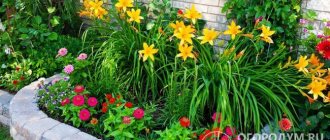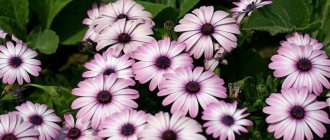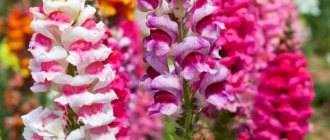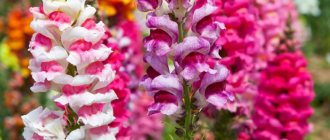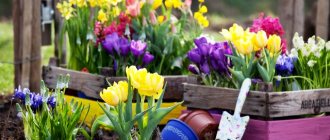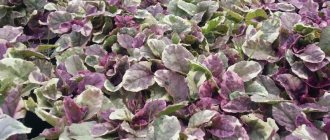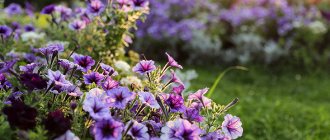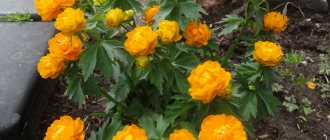Before you start creating a flower garden with perennials, study their requirements for soil, watering, temperature, and flowering times in order to fully meet all agrotechnical requirements. This is especially necessary to do in the initial period of cultivation, which will ensure their further proper development.
Don't expect lush flowering in the first year of planting. Flowers need to take root well, get stronger and gain green mass to reach their full potential next year.
Think in advance about how the grown bush will look in this place three to four years after planting. After all, it is important that it fits into the composition being created as best as possible.
Most perennial flowers in flower beds tolerate the coldest temperatures. Therefore, you don’t have to worry about how the flowers will survive the winter. And with the arrival of warmth, this type of plant begins to bloom first. This is due to the fact that perennials have developed a strong root system over the past years.
Perennials are divided into climbing, tall, medium-growing and low-growing or ground cover. Taking this into account, flower beds, flower beds, ridges or rock gardens are arranged. If you are not a fan of caring for plants or don’t have time, then choose unpretentious perennials.
Now let's get acquainted with some perennial flowers, maybe not quite ordinary, but bright and elegant.
✦ Secrets of the gardener: Perennial phloxes: care and planting in open ground, photos and advice from our expert
Rules for choosing plants for a flower bed
Among perennials there are varieties divided by height, time and duration of flowering, light-loving and unpretentious shade-tolerant flowers for the garden.
From such a variety of species, you can create an original composition for a flower bed, which, once planted, will grow on its own, not requiring special care and attention, which is important for summer residents.
Botanical certificate
Perennials are floral and ornamental herbaceous plants that live in one place for several (more than two) years. Their life cycle is a series of periods of growth and dormancy. They overwinter in the form of rhizomes (astilbe, peony, phlox, rudbeckia, cornflower), bulbs (tulip, narcissus, hyacinth, lily, decorative onions), tubers (dahlia, canna) and corms (crocus, gladiolus). The renewal buds of these underground organs wake up every spring, begin to grow and give rise to new plants.
Rhizomatous plants are propagated by dividing rhizomes in the spring or by dividing the leafy mother plant into daughter clones in the fall.
For some bulbs (tulips, daffodils) a dormant period is recommended: the bulbs are dug up, dried, the children are separated and planted again
Dahlia tubers and gladioli corms are stored in a dark, cool place until spring.
We create a blooming garden with our own hands: how to form a flower bed from perennials
To design a colorful flower bed, it is important to think through the smallest details, because its inhabitants will “live” in a permanent place for several years. By comparing the color options suggested above with descriptions and photos, you can independently think through the layout of the flower garden. Free computer programs that are used to design the landscape design of a site will help you with this. You can also turn to professionals - landscape designers or gardeners, who will competently select crops for decorating any type of flower bed, comparing their qualities, petal color, and growth.
When forming a flower garden, you should rely on these rules:
- Preliminarily study the varieties of flower beds and choose an option that is suitable in shape, size, and location.
- Arrange perennials according to flowering time. It is important to select flowers so that after one species withers, the second begins to bloom, covering the dying vegetation.
- Stick to the correct grouping. Crops must be selected taking into account their height and width, and aggressiveness towards their “neighbors.” Some flowers are capable of growing quickly, oppressing other individuals, and if the grouping is incorrect according to growth, a loss of decorativeness due to shading is possible. Take care of an underground fence that will protect the flowers from the aggressive growth of neighbors.
- Select crops according to method of use. Loaches will decorate an arch or the facade of a house. Tall individuals will serve as the center of the composition or the background, and low-growing flowers will take a good place in the foreground, decorate the border, alpine hill, and fill the ridge. If necessary, you should consider reliable support.
- Do not neglect preparing the seats. Each inhabitant of the flowerbed has its own requirements for the substrate, the degree of illumination, the pH of the soil, and its structure.
- Although perennials are unpretentious, when planting you need to immediately apply long-acting fertilizers that will nourish the green plants, maintaining health and lush flowering.
Advice! If the selected representatives of the flora have different soil requirements, the planting site should be prepared taking into account individual needs.
Narcissus
The plant is one of the first to bloom in spring. Flowers can be double or smooth, and have different shapes depending on the variety.
Planting this perennial is not difficult: the appropriate time to plant purchased bulbs is usually indicated on the package. The main thing in care is to maintain regular watering, periodically loosen the soil and remove diseased plants in a timely manner.
In the garden plot, daffodils are often combined with tulips. This combination looks very impressive in flower beds.
How to choose varieties of flower plants
In order to correctly create a composition of perennial flowers, you must first of all decide which plants you want to see on your site.
For this purpose, there are many catalogs of flowers, which are presented in them by classification, description, flowering period, height. This will help you grow an unforgettable composition on your site, which will be your individual design solution.
Ground cover perennials
Among the low-growing perennial flowers, there are many plants that cover the garden or an unsightly area in the country with a blooming carpet.
Aubrieta
Indispensable flowers for an alpine hill. You can plant aubrieta either on its own or to decorate borders, flower beds, and edgings. Flowering from May to mid-July. But, if after flowering the aubrieta bushes are trimmed, it repeats the flowering. The plant leaves for the winter with attractive leaves. It is important to remember that obrieta grows aggressively and quickly. It can not only suppress other cultures, but also survive.
Arabis
Flowering begins in early May and continues almost until late autumn or until frost occurs. The plant belongs to the ground cover, the length of the shoots reaches from 20 to 25 cm. Soon after planting, Arabis creates a very dense carpet, which is entirely covered with pink, white or lilac flowers. To prolong the flowering and aesthetics of the bushes, faded flowers are cut off. The optimal soil for Arabis is considered to be light soil fertilized with nitrogen fertilizers. Arabis is an excellent option when you need to decorate a slide, border, or path.
We recommend studying: secrets of growing Mallow seedlings from seeds - a new way
Loosestrife
The varieties of loosestrife are such that the plant can be planted as a ground cover, as a medium-growing plant, and as a tall plant. But all species have one thing in common - loosestrife is an unpretentious plant. Loosestrife can adapt very quickly to new conditions. The height of the plant varies from 15 to 75 cm. Loosestrife grows both in the shade and in the scorching sun. Meadow or coin loosestrife is planted in partial shade and shade. This type of loosestrife has recumbent shoots that are decorated with small yellow flowers.
To decorate a flower garden or rock garden, use loosestrife, whose shoots are erect. The inflorescences on such plants have medium-sized flowers collected in a spike.
Any species of loosestrife tolerate winter well and are not afraid of severe frosts. The crop is also slightly susceptible to pest invasion.
Narrow-leaved lavender
This species is also called garden lavender. Low-growing perennials have a very compact shape, flowering is observed from June to October. Lavender is a honey plant, so it is often planted in the garden to attract bees. The plant is easy to grow and there are no special care requirements. The leaves are evergreen and have a coating that gives the leaves a silvery tint.
Fuopsis
Lush flowering and fragrant perennial. The bushes do not grow above 25 cm. Fuopsis quickly spreads a flowering carpet over the surface. The shoots and leaves contain coumarin, which gives the plant a musky aroma, especially noticeable after rain. Flowering begins in early June and lasts until the end of summer. It is beneficial to plant fuopsis in areas that need to be decorated. Grows well over large areas. The plant is resistant to frost and pests.
Flowering perennials are used to create compositions of incredible beauty in gardens. This, of course, requires knowledge in this area. But, contrary to the prevailing opinion among flower growers that they need special and constant care, there are many among them that are completely unpretentious plants that do not require attention.
We recommend studying: proper cultivation of broccoli in open ground
Asters
Feels great both in the sun and in partial shade. Flowering is abundant and long lasting – almost until frost. Asters are loved by flower growers due to the huge variety of species and varieties, as well as their unpretentiousness. It is usually planted along the edges of garden paths and flower beds.
How to water and fertilize asters so that they bloom longer? During this period, abundant watering is necessary. Feed the plant before flowering with mineral fertilizers or organic matter. The soil at the planting site should be loose and well permeable to water.
How to choose seeds for planting
When choosing seeds of perennial flowers, you need to take into account the time of their planting, correctly understand their growing conditions, growing seasons and height of growth.
Tall ones are planted later so as not to shade other species. They begin to bloom later than everyone else. These include lilies, gladioli, dahlias, and peonies.



